AUGER Lifeboat No. 6
Note: Page tabs may appear collapsed or as a menu near the top of the page on mobile devices or lower screen resolutions.
This incident occurred on FPS AUGER, a Tension Leg Platform (TLP) at Garden Banks Block 426 in the Gulf of Mexico, on June 30, 2019 and resulted in the untimely deaths of two personnel and injury to a third person. The incident occurred when Lifeboat 6 released from the fall cables during recovery after a routine launch and perceived U.S. Coast Guard requirements.
Our condolences go to the families of the two men that lost their lives during this incident.
The USCG formal investigation has been completed, endorsed by the District Commander, Coast Guard District Eight and was initially released by USCG Headquarters on December 16, 2021. Commandant actions were completed on October 2, 2023. A bookmarked copy of the Report of Investigation (ROI) is available here.
The Coast Guard publicized the release of the ROI via Maritime Commons blog post and requested "any feedback regarding the recommendations in the report" to be provided no later than February 1, 2022. See the Recommendations & Actions tab above for the safety and administrative recommendations made in the report. See also the Commandant Letter (CG-5P) and District Commander's endorsement at the beginning of the report for recommended actions in relation to the recommendations and Coast Guard actions taken (these are also shown on the Recommendations & Actions tab).
Use the tabs on this page (above) to view the following information related to Safety Alert 03-20 that was released while the investigation was in process to promulgate pertinent information and safety concerns, as well as additional information available since the release of the Report of Investigation:
1) Introduction (this tab);
2) Executive Summary (as presented in the Report of Investigation;
3) Graphical representation of the sequence of the lifeboat retrieval and accident;
4) Event and maintenance timelines related to the accident;
5) U.S. Coast Guard Safety Alert 03-20 and the related recommendations;
6) Presentation and Videos detailing observations related to Safety Alert 03-20 and the Report of Investigation;
7) Graphical depictions and accompanying explanation detailing observations related to control cable findings promulgated via Safety Alert 03-20 and detailed in the Report of Investigation;
8) USCG Testing of Schat-Harding LHR 3.5M2 Release Mechanism, Enclosure (2) to the Report of Investigation;
9) Safety and administrative recommendations from the Report of Investigation (with recommendation references hyperlinked or included for ready reference), Endorsements and Commandant Actions.
10) Findings of Concern (published after the investigation was officially closed).
Executive Summary (from the Report of Investigation)
For more details see the full Report of Investigation.
On Sunday, June 30, 2019, at approximately 10:00 a.m., the aft hook on Shell AUGER’s1 Lifeboat No. 6 inadvertently opened as the lifeboat was being winched into the davit following a quarterly launch and retrieval drill. The lifeboat, still hanging from the forward hook, swung in a pendulum motion away from the facility. A few seconds later, the forward hook separated from the lifeboat and opened, and the lifeboat fell approximately 80 feet, landing inverted in the water. The two persons still onboard the lifeboat when it fell were fatally injured. One person, who was exiting the lifeboat when it released, fell into the water and was injured. The lifeboat was a total loss.
Lifeboat No. 6 was a 33-man 24-foot enclosed, dual-fall lifeboat manufactured by Watercraft America2 in 1984 and refurbished in 2012. Lifeboat No. 6 was outfitted with a Schat-Harding3 SeaCure LHR3.5M2 release mechanism.
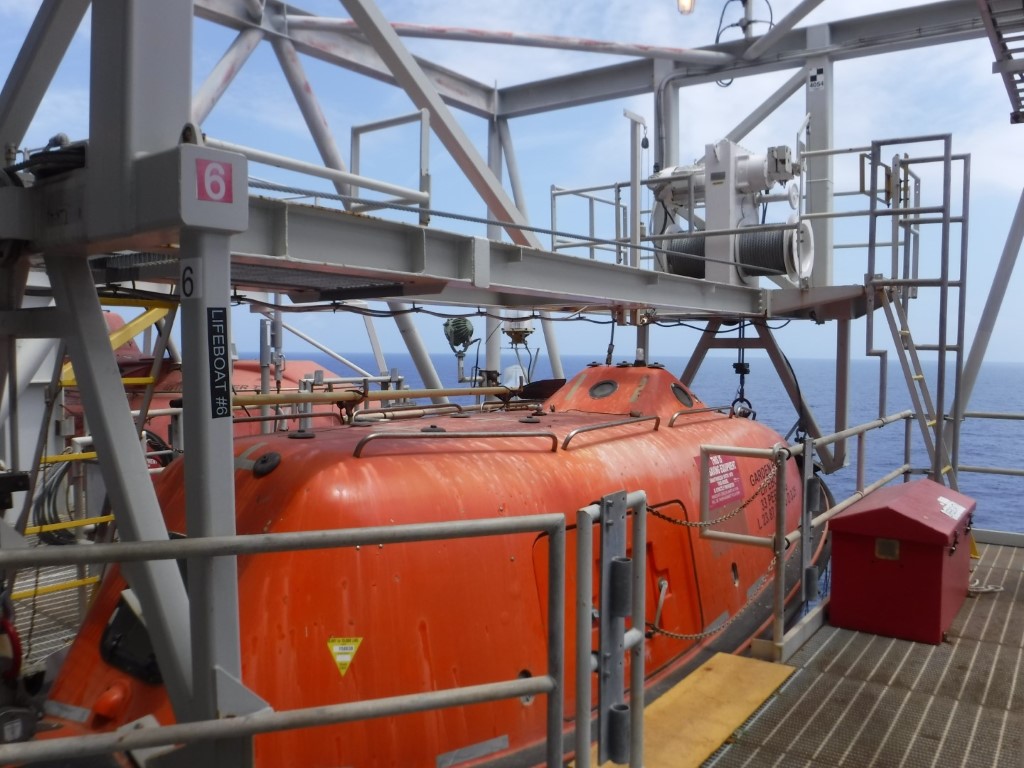
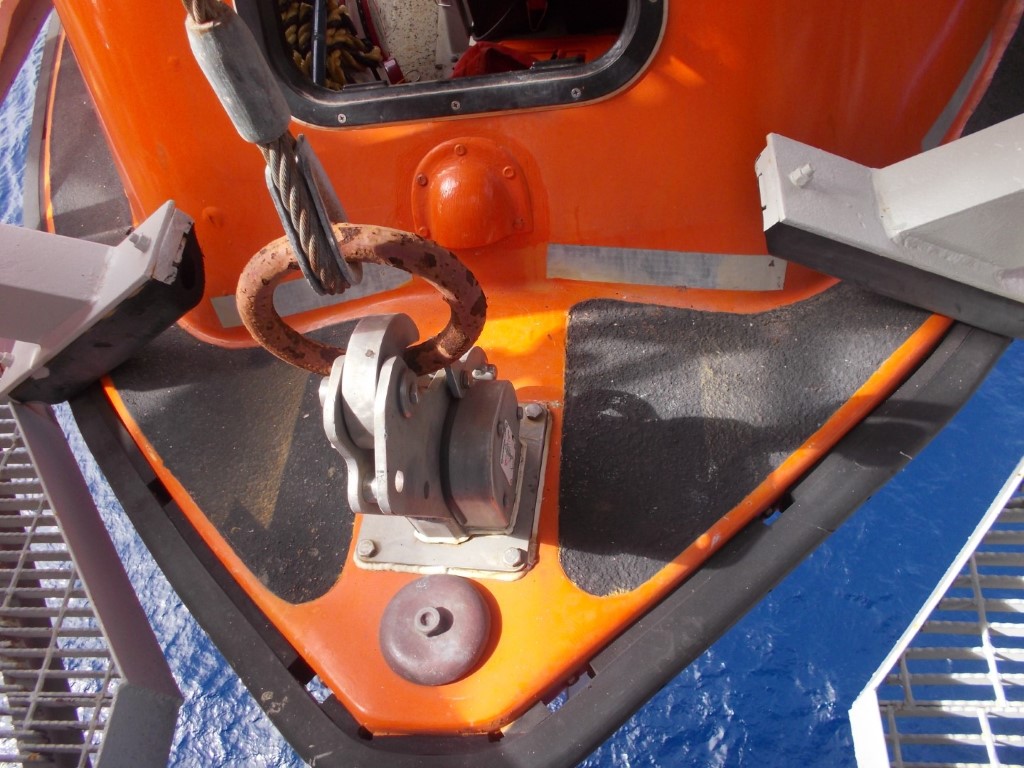
Image 1 (left): AUGER Lifeboat No. 6 prior to the casualty (Photo credit: Palfinger Marine; taken May 2019).
Image 2 (right): AUGER Lifeboat No. 6 aft hook and lifting ring (Credit: Palfinger Marine; taken June 2014).
The release mechanism was comprised of two hooks, a hook release unit (located inside the lifeboat adjacent to the helm), a hydrostat unit, and three control (push-pull) cables (see Image 3). One control cable connected the hook release unit to the aft hook, the second control cable connected the release unit to the forward hook, and the third control cable connected the release unit to the hydrostat unit
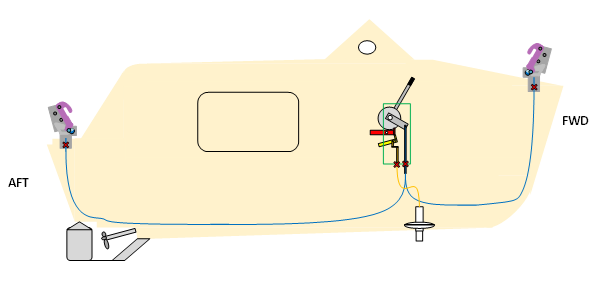
Image 3: Graphic of Watercraft EL-24 outfitted with Schat-Harding LHR3.5M2 release mechanism (Credit: Shell Offshore).
The hook control cables are heavy duty low friction cables with threaded end fittings and four inches of travel at the end rods (see Image 4). Each cable has an outer conduit and an inner member. The conduit is comprised of three layers: a green plastic cover; steel reinforcement; and a white polyethylene liner. The conduit provides a protected path for the steel inner member. With the ends of the conduit fixed at each terminal point (provided it is not fully compromised), the conduit also controls the travel length of the inner member. The inner member transmits linear motion from the hook release unit to the locking shafts located within the hooks via the end rods.

Image 4: Control cable components (Credit: Cablecraft, modified by the USCG).
Generally, the system works in the following manner: When closing or resetting a hook, an operator positioned at the release unit pulls up on the safety lock and pushes forward on the control handle, locking it into place. Consequently, the end rod on the hook end extends. This extension causes the hook’s locking shaft to move to the closed or locked position. When opening the hook, the opposite actions and forces apply.
During the course of the investigation, the Coast Guard, Shell, and Palfinger Marine (the original equipment manufacturer or “OEM”) identified a previously unknown vulnerability in the system: if all three layers of the conduit of a hook control cable separate or break, during a reset the locking shaft may not return to the fully closed position. Rather, the locking shaft may come to rest at an “almost open” position (see Image 5). In such a position, the hooks can support the weight of the boat and its occupants during retrieval. However, an additional load can cause the locking shaft to rotate to the open position, releasing the hook.

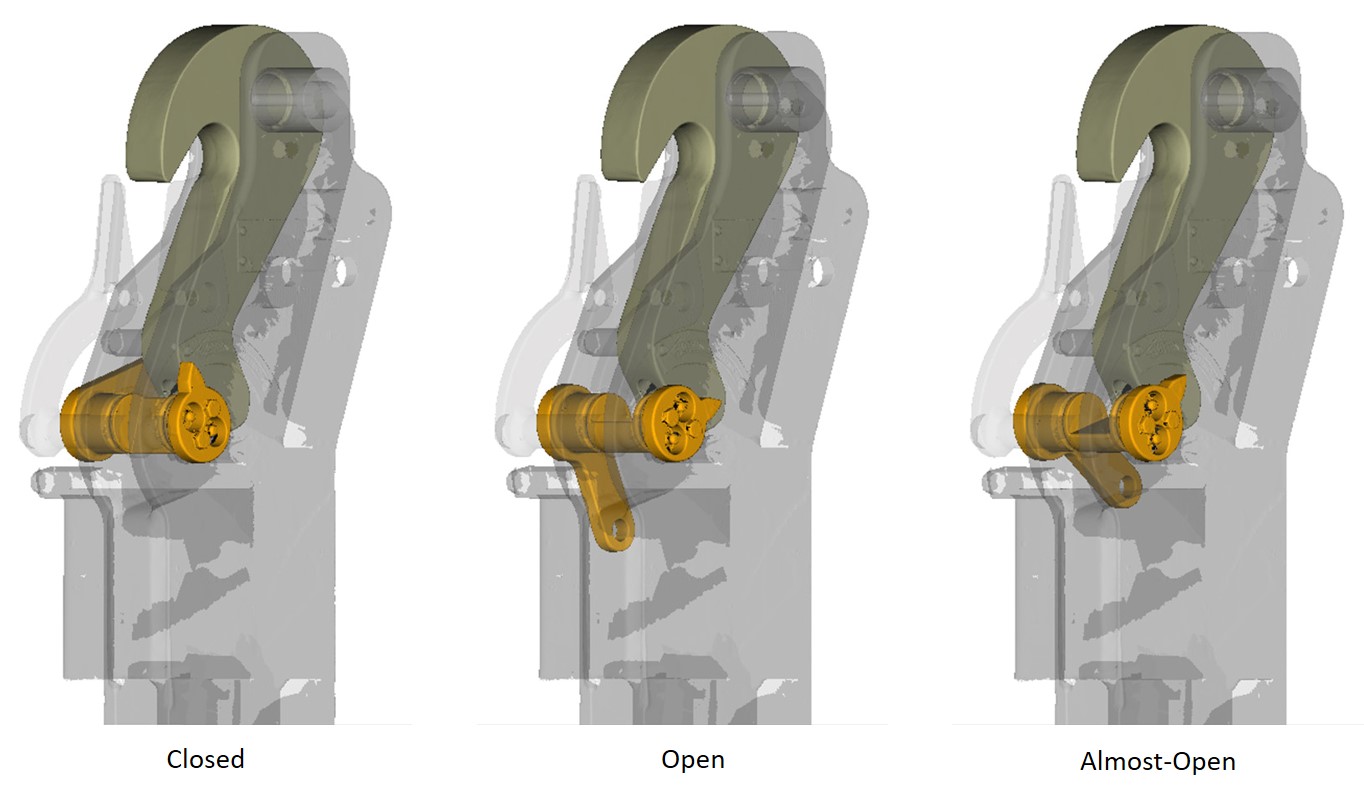
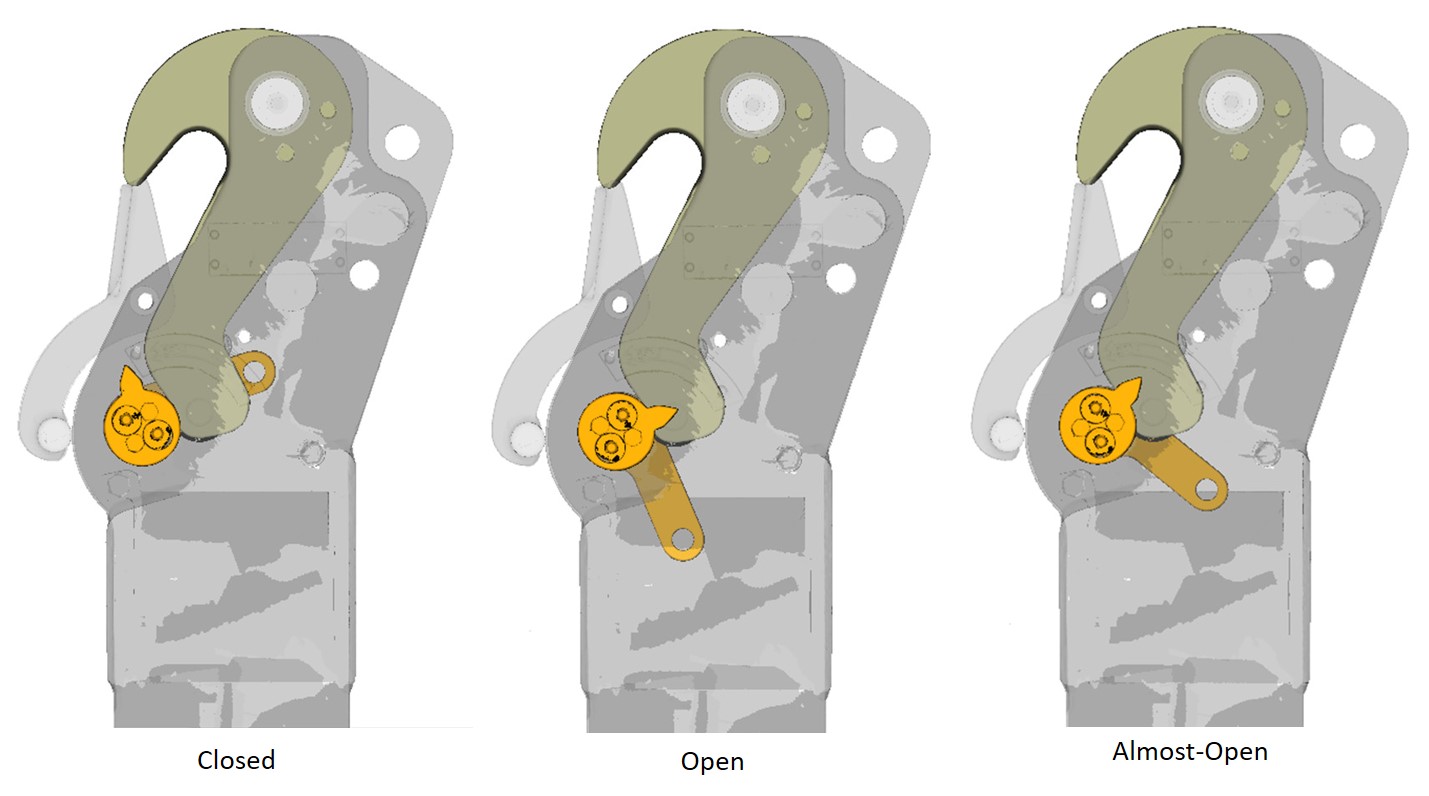
Image 5: Hook cutaway views of LHR3.5M2 hook in closed, open and almost open positions. Locking shaft depicted in yellow. (Credit: USCG (hook component data provided by DNV-GL)).
On the morning of June 30, 2019, Lifeboat No. 6 was launched and initially retrieved without incident. However, unknown to the launch crew and boat crew, but documented in an OEM service report completed on or about June 6, 2019, a section of the aft hook control cable conduit was corroded and damaged, although not fully separated.
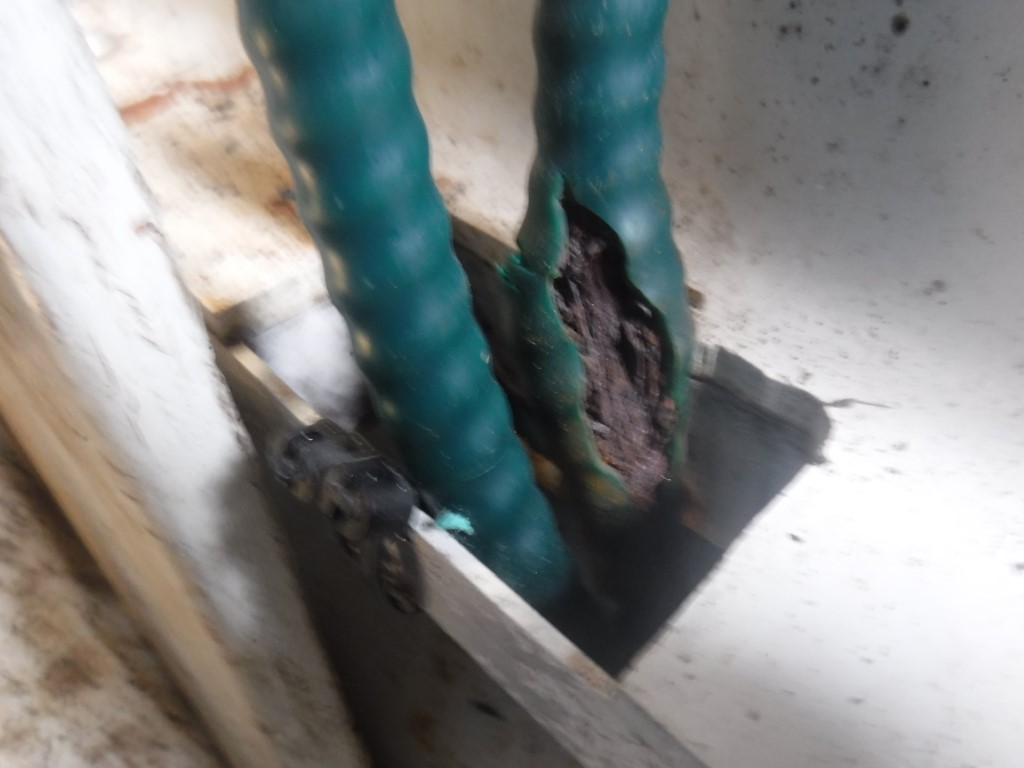
Image 6: Photograph of damage to Lifeboat No. 6 aft control cable dated (Credit: Palfinger Marine; taken June 6, 2019).
On the day of the casualty, the crew cycled the hooks (open to closed position) two times while in the water. If a cable conduit is already damaged, the act of cycling exposes the conduit layers to additional stresses, including compression and tension (stretching). It is probable4 that during the second cycling event, the conduit, already weakened and damaged, separated during the closing action (see Image 7). As a result, when the system was reset, the locking shaft on the aft hook did not return to the fully closed position, but rather, came to rest at an “almost open” position. In this position, the hook could support the weight of the lifeboat and its occupants as the lifeboat was hoisted from the water to the davit. However, at the davit, additional forces applied to the hook and the lifeboat, as a result of the winch pulling the boat against the bumpers, caused the locking shaft to rotate from the “almost open” to the open position. Under load, the aft hook was free to open and release from the lift ring (a ring attached to the end of the fall cable (wire rope); often called the “D” ring). The forward hook, not designed to bear the entire load of the lifeboat or operate outside of specified angles, was unable to sustain the weight of the lifeboat, separated from the hull and eventually opened.
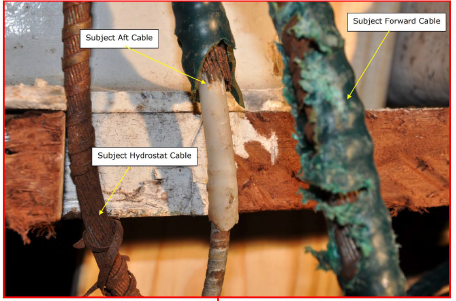
Image 7: Photograph of aft control cable after casualty. Photograph documents separation of three layers
of the conduit: the green plastic cover; a steel wire; and a white polyethylene liner. Credit: DNV-GL.
The investigation team determined that the initiating event for this casualty occurred when the locking shaft on the aft hook moved from the “almost open” to the open position, which in turn caused the aft hook to open under load and release from the lift ring. Subsequent to the initiating event, the forward hook, bearing the entire load of the lifeboat, separated from the hull and opened. The lifeboat fell approximately 80 feet, with two persons still onboard, and landed inverted in the water.
The primary causal factor that directly contributed to the casualty was the complete separation of the aft hook control cable conduit surrounding the inner member.
Other causal factors include:
1) the operator and/or OEM’s failure to replace the aft hook control cable after it was identified as damaged;
2) the operator and/or OEM’s act of allowing Lifeboat No. 6 to stay in service after the aft hook control cable was identified as damaged;
3) the operator’s, OEM’s, and regulators’ lack of knowledge that a compromised hook control cable could allow a locking shaft to stop at a position short of fully closed after reset;
4) the operators and OEM’s lack of effective communications related to roles and responsibilities; and
5) operator’s and OEM’s focus on function-based inspections vice condition-based inspections, as related to the control cables.
Contributing factors include the lack of systems, policies or regulations in existence to ensure that control cables are properly monitored and changed out in accordance with the OEM’s recommendations and/or best industry practices.
Footnotes:
1 Shell AUGER is a floating OCS facility (FOF) of the tension leg design located in the Gulf of Mexico. It is operated by Shell Offshore.
2 The Watercraft America brand is now owned by Palfinger Marine.
3 The Schat-Harding brand is also now owned by Palfinger Marine.
4 In this investigation, Coast Guard investigators use the terms “probable,” and “possible” to communicate confidence in certain conclusions. When investigators use the term “probable” it means that after assessing all evidence, they believe the likelihood of the conclusion being true is more likely than not (51% or more). When investigators use the term “possible,” it means that after assessing all the evidence, they believe that the conclusion is feasible but cannot be declared probable.
Timelines Related to the Investigation
The event timeline below details the sequence of events from the meeting for the training evolution through the casualty and recovery of personnel and securing of the lifeboat by an OSV that responded to the accident. Click here for a pdf of the event timeline.
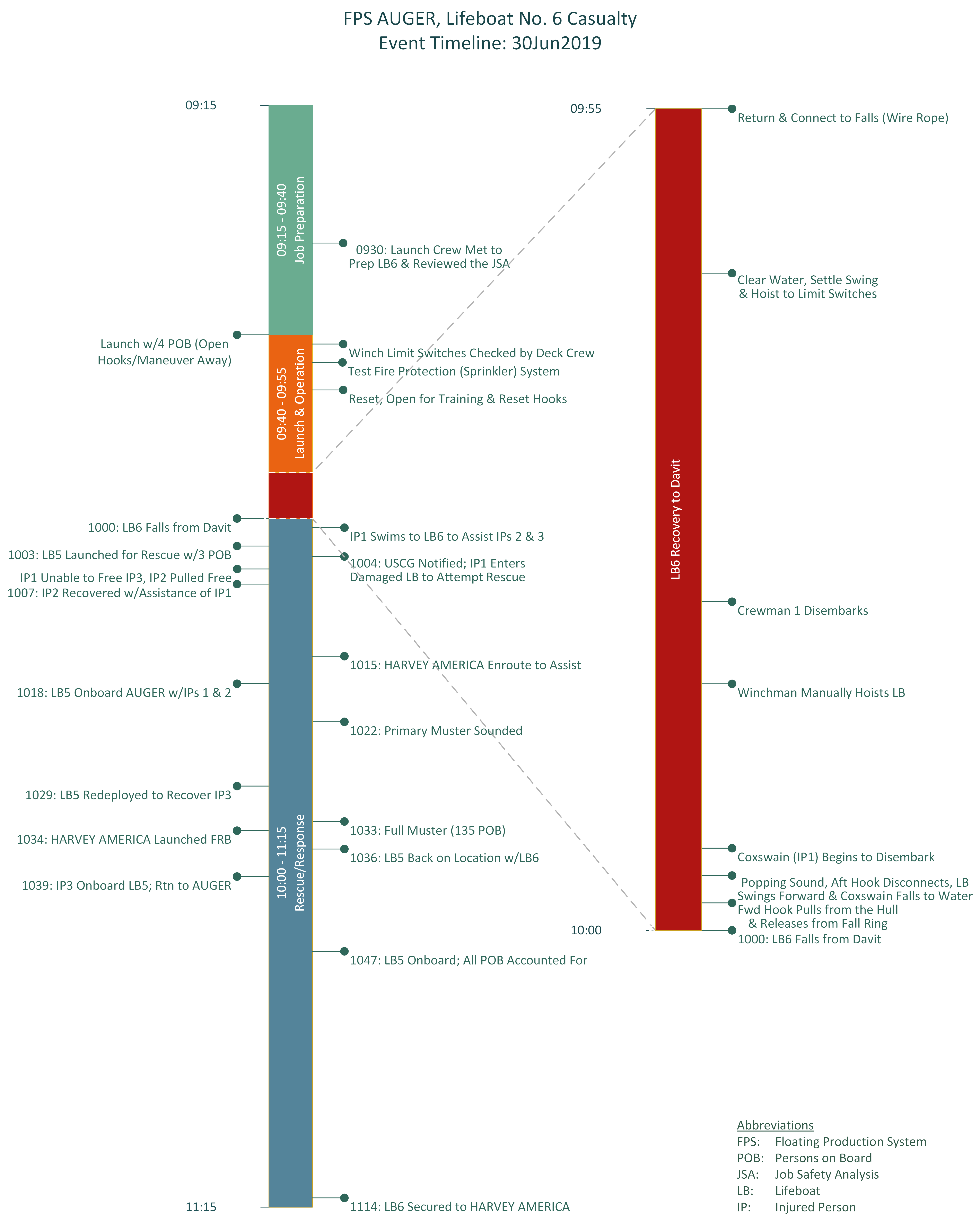
The maintenance timeline below lists the refurbishment and release gear replacement (2012) and service provider maintenance events documented for Lifeboat 6 up to the day of the casualty. See the Report of Investigation for more details about the boat prior to refurbishment. Click here for a pdf of the maintenance timeline.
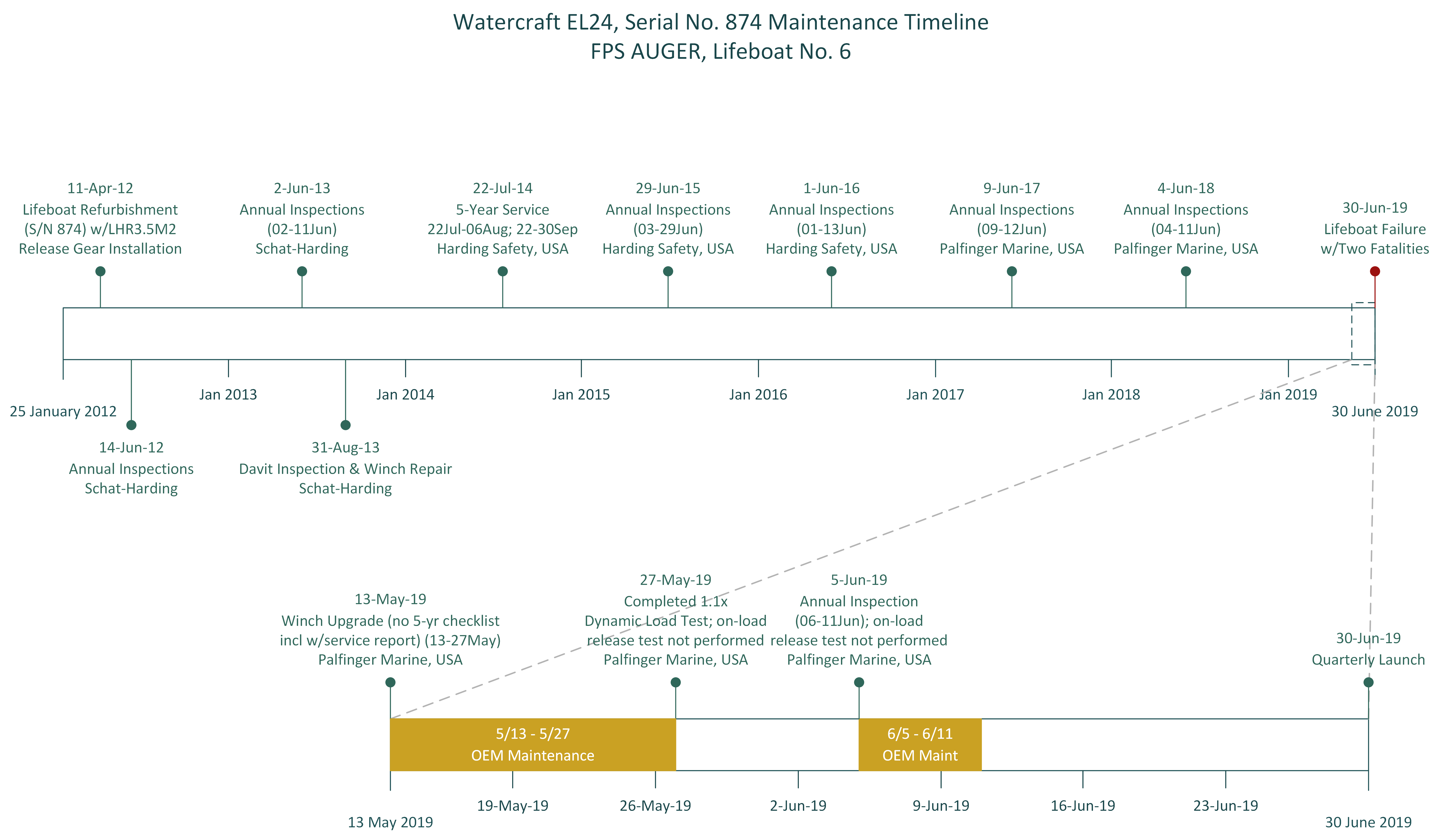
Safety Alert Overview
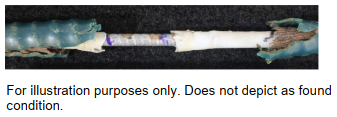 Safety Alert 03-20 was published on February 5, 2020, after observations and testing revealed that a damaged/compromised hook control cable could fail in a manner that would allow a hook to open, essentially defeating the safety features that are incorporated into the design of a lifeboat release gear system. Prior failures with these types of control cables were assumed to be 1) a seized cable or 2) a severed cable. Shell Offshore, Inc. and USCG investigation team members observed that another failure mode was possible, as summarized in the safety alert:
Safety Alert 03-20 was published on February 5, 2020, after observations and testing revealed that a damaged/compromised hook control cable could fail in a manner that would allow a hook to open, essentially defeating the safety features that are incorporated into the design of a lifeboat release gear system. Prior failures with these types of control cables were assumed to be 1) a seized cable or 2) a severed cable. Shell Offshore, Inc. and USCG investigation team members observed that another failure mode was possible, as summarized in the safety alert:
"During post-incident laboratory testing the Coast Guard observed that if a control cable, similar to that shown in the image above, is damaged all the way through the outer layers, leaving the traveling inner member exposed, forces applied directly on the separated outer layers can cause the traveling inner member to pull on each of its ends. As the separated outer layers pull apart, the cable’s end rod at the hook can move, which in turn can rotate the locking shaft inside the hook. If the locking shaft rotates enough, the hook can release, even without an operator touching the release handle or overriding the interlocks. The Coast Guard has no indication that a damaged control cable alone can cause a hook to release or open on-load. However, the Coast Guard believes that damaged control cables pose a significant safety risk and should be replaced before attempting to launch a boat that incorporates control cables into the on-load release capability of a hook release system."
USCG Recommendations
Based on the observations related to release mechanism control cables, the USCG strongly recommends the following in Safety Alert 03-20:
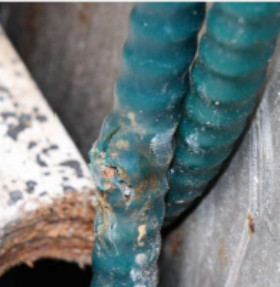 Conduct thorough inspections of control cables between the release handle station and release hooks;
Conduct thorough inspections of control cables between the release handle station and release hooks;
- Inspect any other similar cables communicating between the release station and the hydrostatic interlock, if installed, and
- Look for current damage and for potential hazards or other conditions that might compromise the cables in the future;
- Replace cables that show signs of wear or damage to any layers (photo to the right shows a release mechanism control cable that was in service (at the time the photo was taken) with a compromised conduit);
- Implement an inspection regime that allows for cable damage to be identified and replace cables identified to need replacement in a timely manner.
- Consult the lifeboat and release mechanism operations manual(s) prior to conducting launch and recovery drills.
The safety alert also noted that:
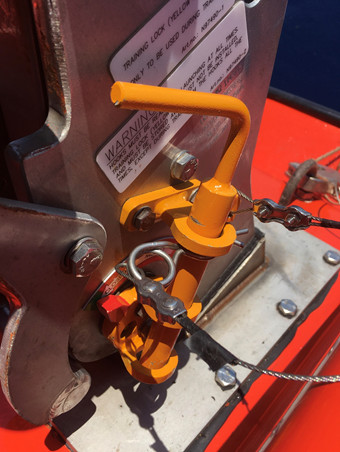 Safety pins (photo to the right shows a Palfinger Marine "Training Lock" installed in an LHR-series hook) can be used during drills to prevent the hook-locking shaft from rotating, when they are approved as part of the release mechanism;
Safety pins (photo to the right shows a Palfinger Marine "Training Lock" installed in an LHR-series hook) can be used during drills to prevent the hook-locking shaft from rotating, when they are approved as part of the release mechanism;- Although safety pins may provide an extra level of safety during drills and training, operators should ensure that lifeboats are stowed in the "ready to launch" condition without safety pins in place; and
- Operators should ensure that lifeboat crews understand that safety pins will prevent a lifeboat from releasing from the fall wires during a real emergency if they are not removed after routine training evolutions or maintenance.
Presentation and Videos
Safety Alert 03-20 and the observations from CG-testing were presented during the September 30, 2020 National Offshore Safety Advisory Committee (NOSAC) meeting (video teleconference). The presentation and individual videos (mp4 format) are available below. Note that the presentation is a large file size (30mb), as the videos are embedded within the presentation, but can also be downloaded separately. Microsoft PowerPoint® or a compatible viewer will be needed to view the presentation.
- Introductory Video: Separated Cable Conduit (2.5mb)
- This video shows what happens if the conduit is extended between the fixed connections at the release unit and the hook. See the graphics below for details on the various control cable conditions and the related effects on the hook.
- Video #2: Subsequent Cycling (after conduit/liner separation; 5.6mb)
- Testing video 2 documents the observations of open and close cycling of the release unit after the control cable conduit (and liner) have separated.
- Video #3: Effect of an Increasing Load (12.3mb)
- Testing video 3 documents the effect of additional loading to a hook with the locking shaft in a partially-closed (i.e., almost-open) position due to a compromised control cable/separated conduit. As shown in the video, additional load can force the locking shaft to open and release the hook, but it has to be very close to the open position to be forced open. USCG testing showed that if the compromised control cable leaves the locking shaft in a position closer to the fully closed position, the locking shaft will not be forced open under increasing load.
Discussion of Observations and Findings related to the Control Cables
Please note that testing was conducted on Schat-Harding LHR-series release gear. As such, the descriptions of components and operation relate to that make and series of release gear. Other manufacturer's release gear designs, functions and component terminology could vary, but the control cable is the area of focus in these findings and could pose a similar vulnerability in other designs.
Generally, the system works in the following manner:
When closing or resetting a hook, an operator positioned at the release unit pulls up on the safety lock and pushes forward on the control handle, locking it into place. Consequently, the end rod on the hook extends. This extension causes the hook's locking shaft to rotate to the closed or locked position. When opening the hook, the opposite actions and forces apply.
A previously unknown vulnerability in the system was identified during the course of the investigation that was referenced in Safety Alert 03-20 and discussed in greater detail in the Report of Investigation: if all three layers of the conduit of a hook cable separate or break during a reset, the locking shaft may not return to the fully-closed position. Rather, the locking shaft may come to rest at an "almost-open" position (see the various positions on the following graphics). In such a position, the hooks can support the weight of the boat and its occupants during retrieval. However, testing has revealed that an additional load can cause the locking shaft to rotate to the open position, releasing the hook.
Please see the presentations and videos tab above to review videos that show the control cable issues that are discussed and portrayed below.
Release Mechanism Arrangement
A typical dual-fall/hook release mechanism is comprised of two hooks, a hook release unit (located inside the lifeboat adjacent to the helm), a hydrostat unit, and three control (push-pull) cables. One control cable connects the hook release unit to the aft hook, the second control cable connects the release unit to the forward hook, and the third control cable connects the release unit to the hydrostat unit.
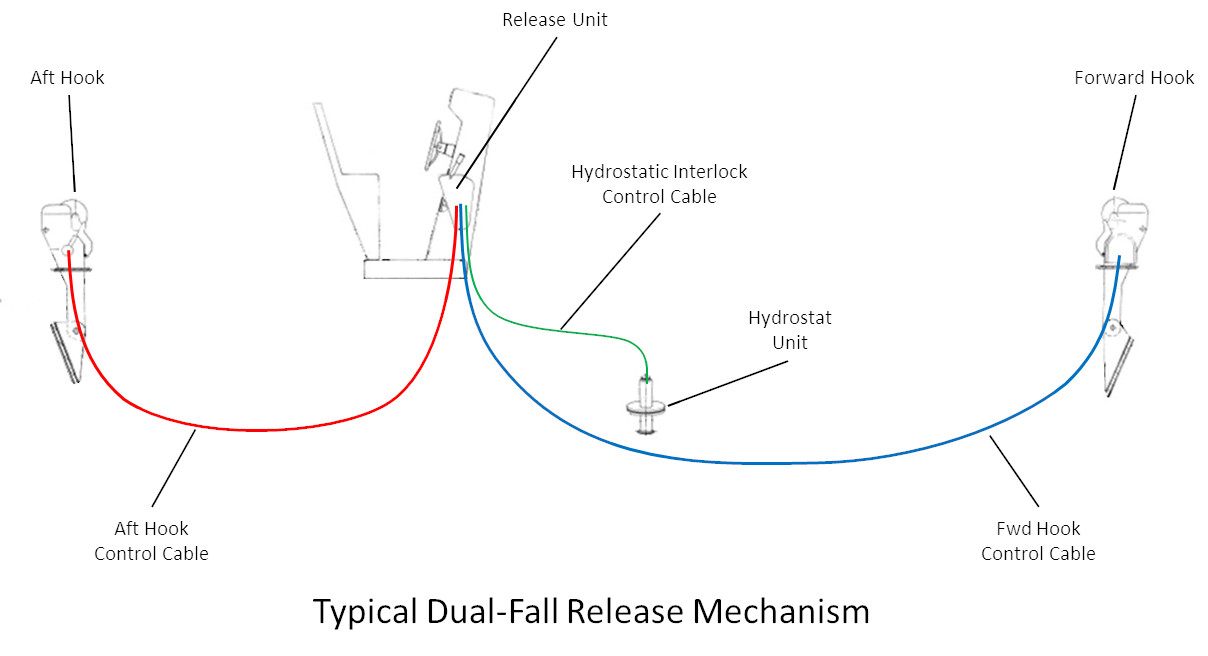
Closed/Reset Position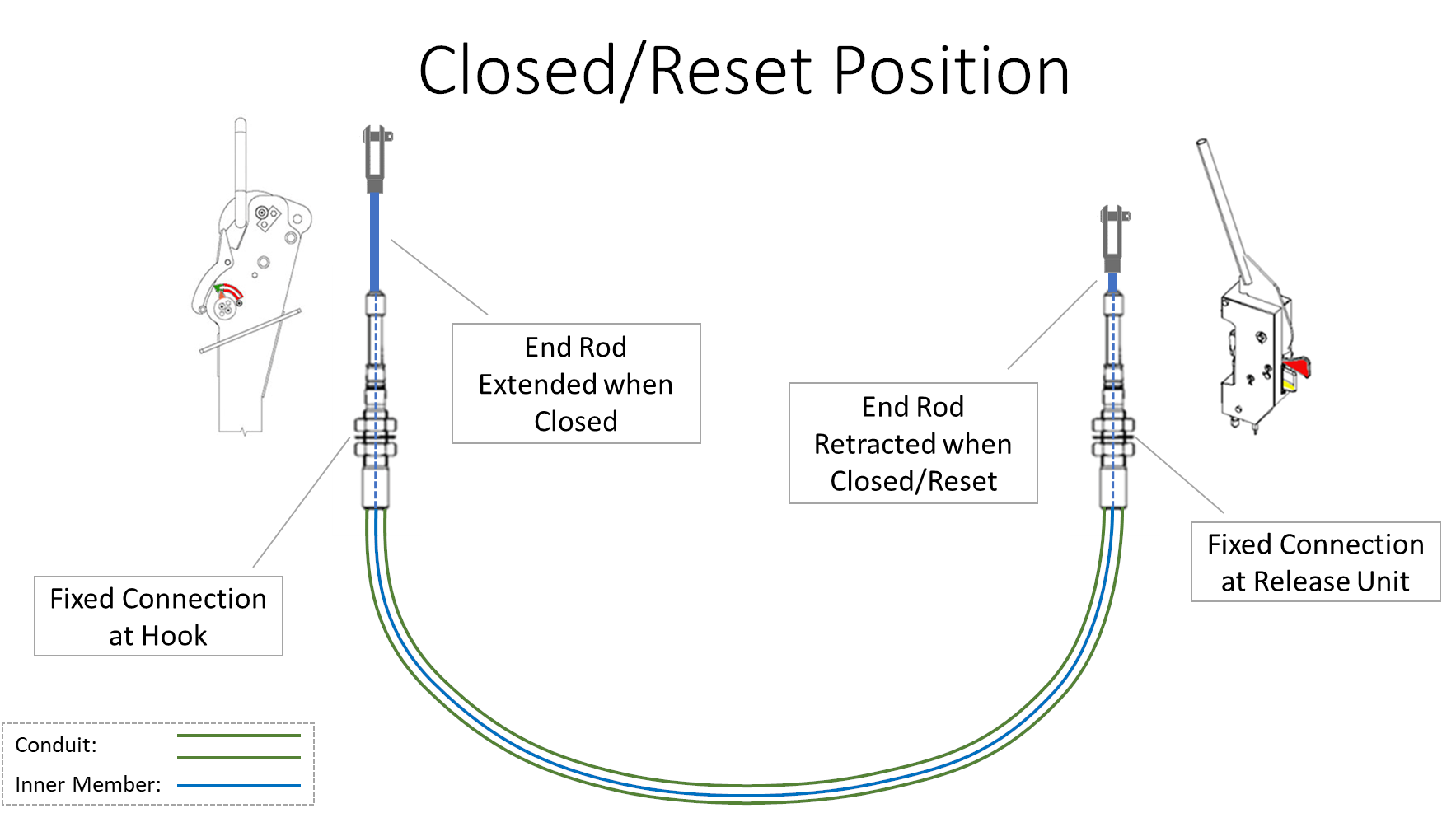
This graphic shows the positions of the control cable and the hook when the release unit handle is in the closed, or reset, position.
Open/Released Position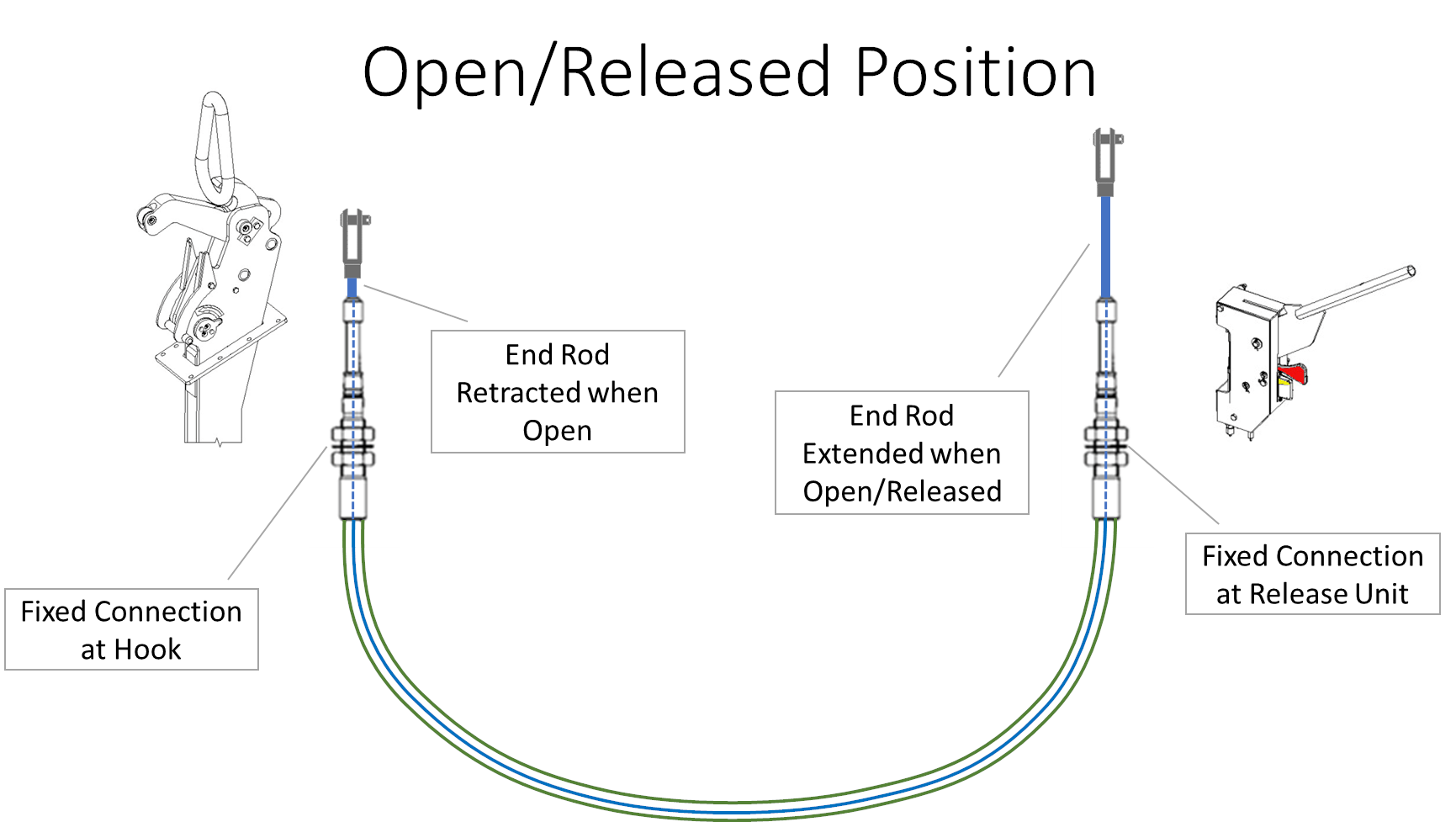
This graphic depicts the actions of the control cable and the hook when the release unit handle is moved into the open, or released, position.
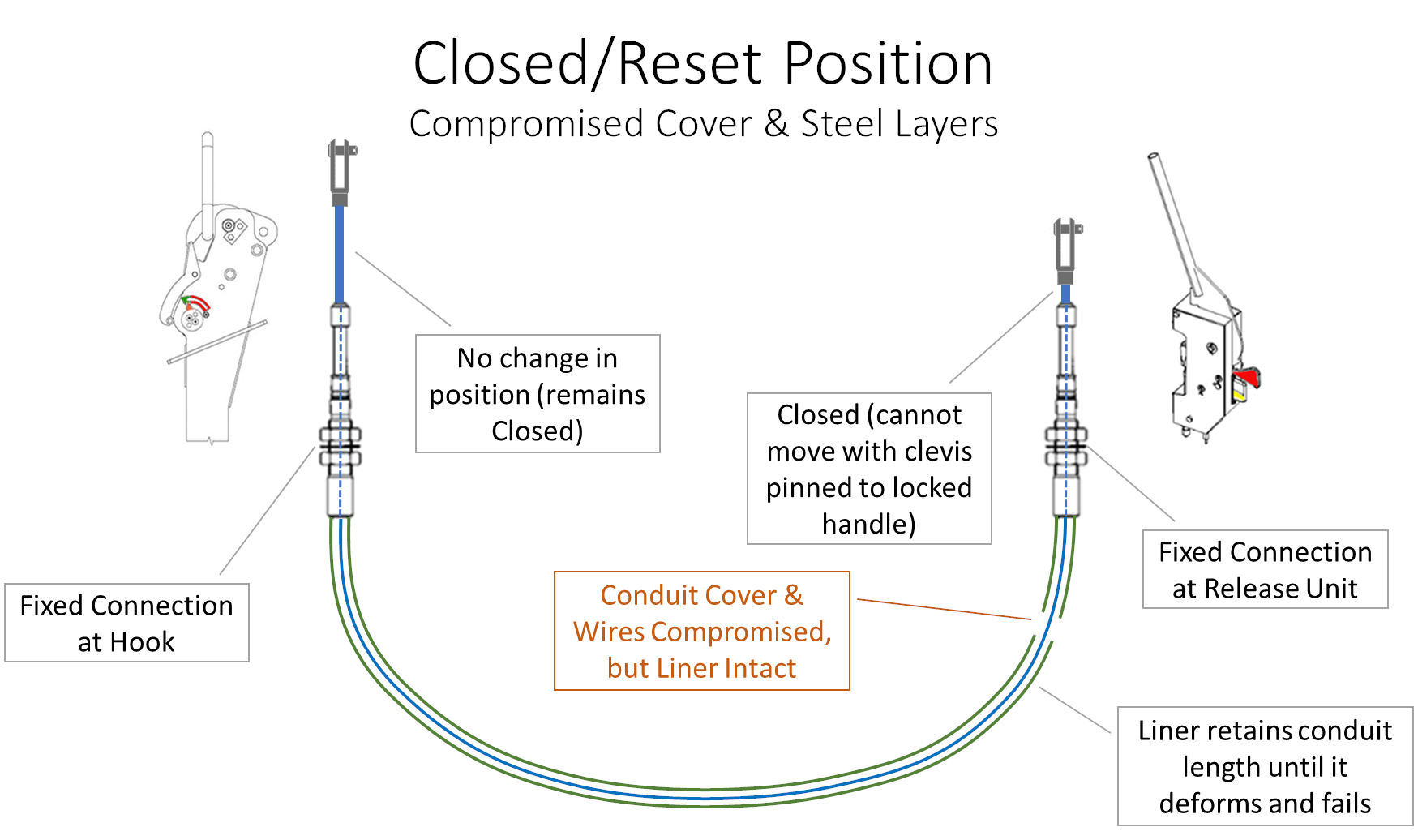 Closed/Reset Position with
Closed/Reset Position with
compromised cover and steel layers
With the conduit cover and steel reinforcement compromised but the liner still intact, the system continues to function. In this condition, the liner is subjected to compression and tension forces that correspond to the open and close motions of the release handle that is transmitted through the control cable.
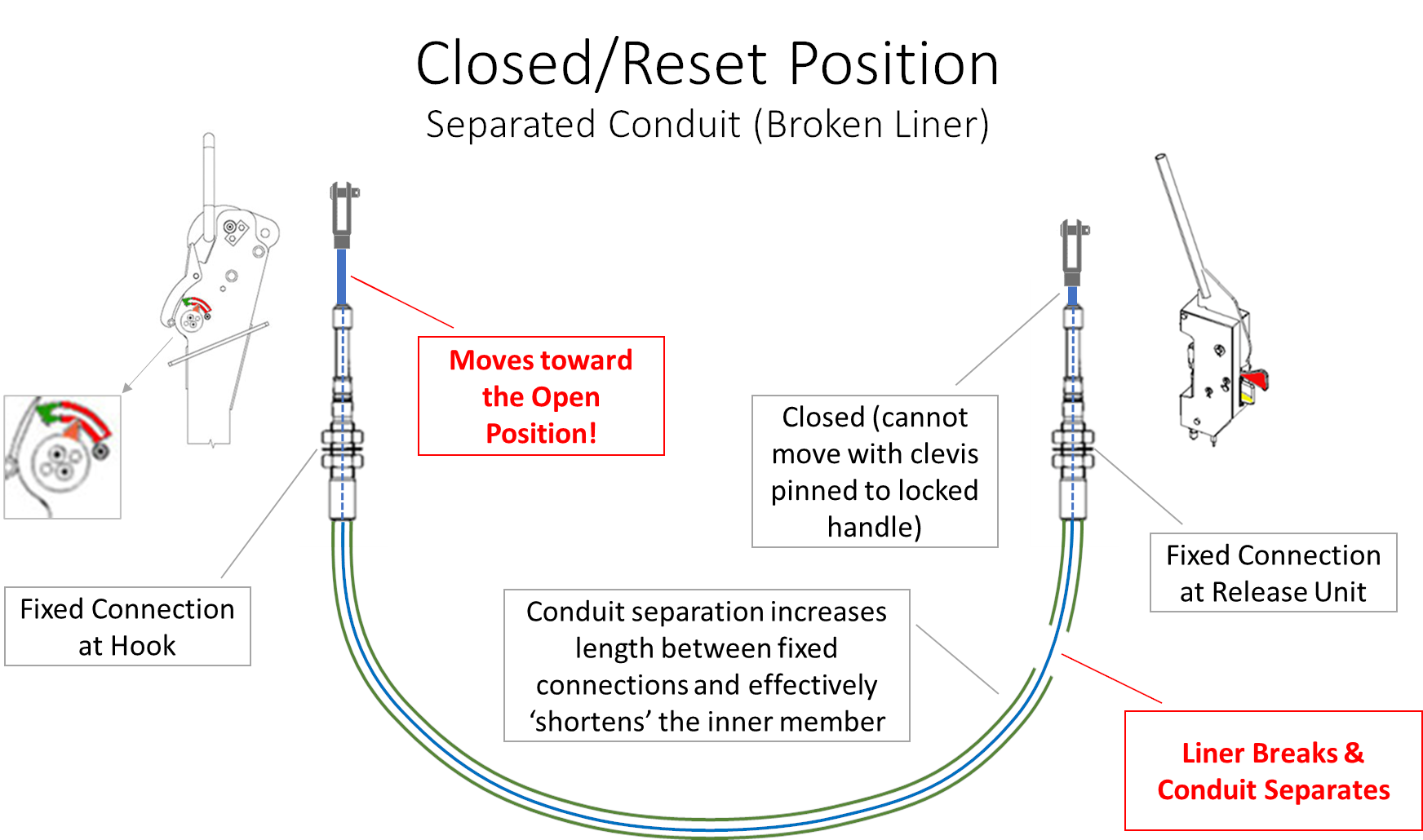 Closed/Reset Position with
Closed/Reset Position with
separated conduit (broken liner)
The conduit tends to separate after the liner breaks. This separation causes the conduit to lengthen and results in the inner member moving the locking shaft arm toward the open position. During testing, it was observed that the:
- liner separated during the closing motion of the release handle (the liner is under tension during this motion);
- locking shaft stopped rotating toward closed when the liner separated and remained in a partially-closed position; and
- conduit separated during the remaining closing action of the release handle (less resistance require to separate the conduit than to rotate the locking shaft).
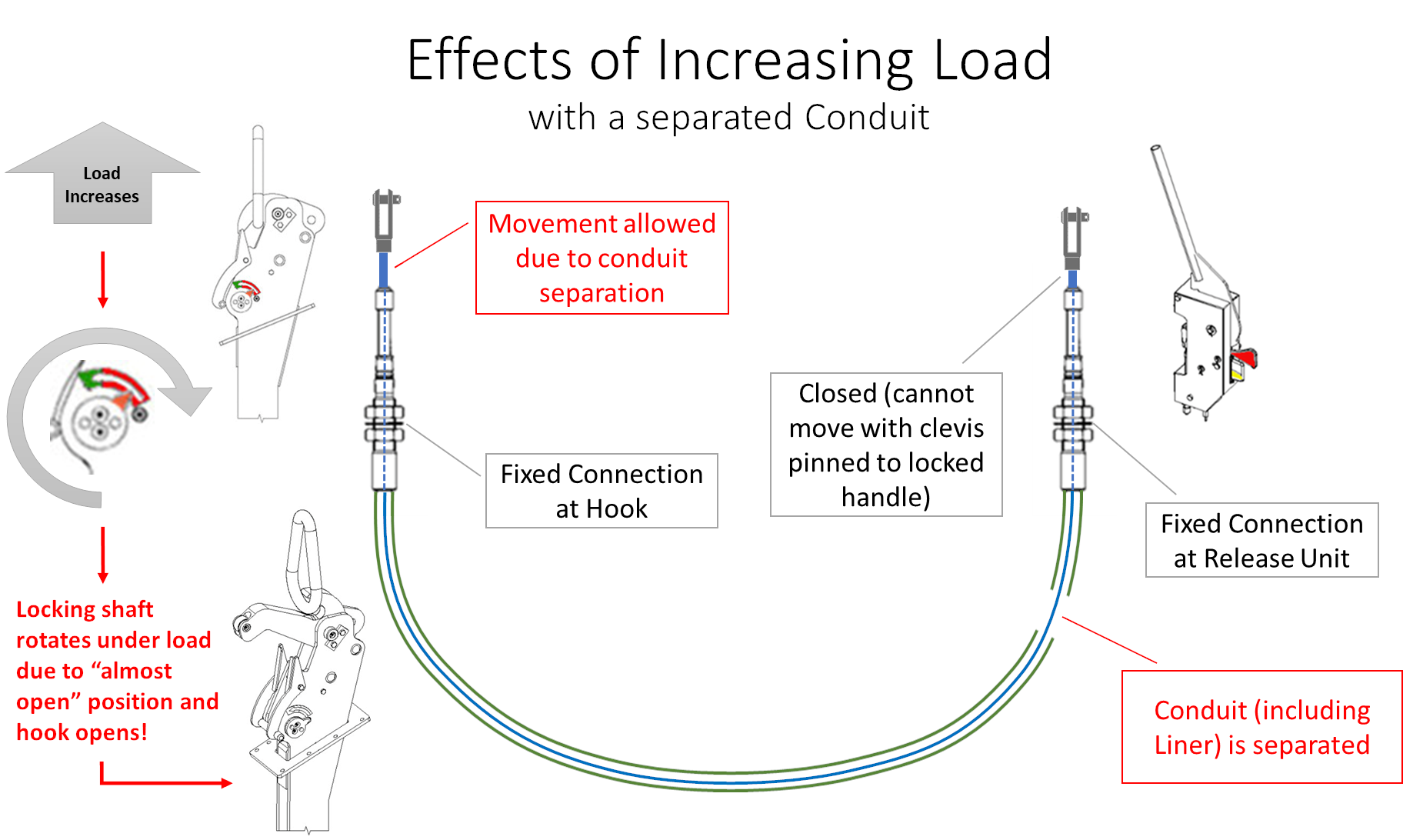 Effects of Increasing Load with
Effects of Increasing Load with
a separated conduit
Testing confirmed that the locking shaft can be in a partially-closed position that will support the weight of the boat and occupants, but can rotate to the open position with an increasing load/additional weight (such as the additional load that can be imparted to the hooks as a boat is pulled against the davit bumpers).
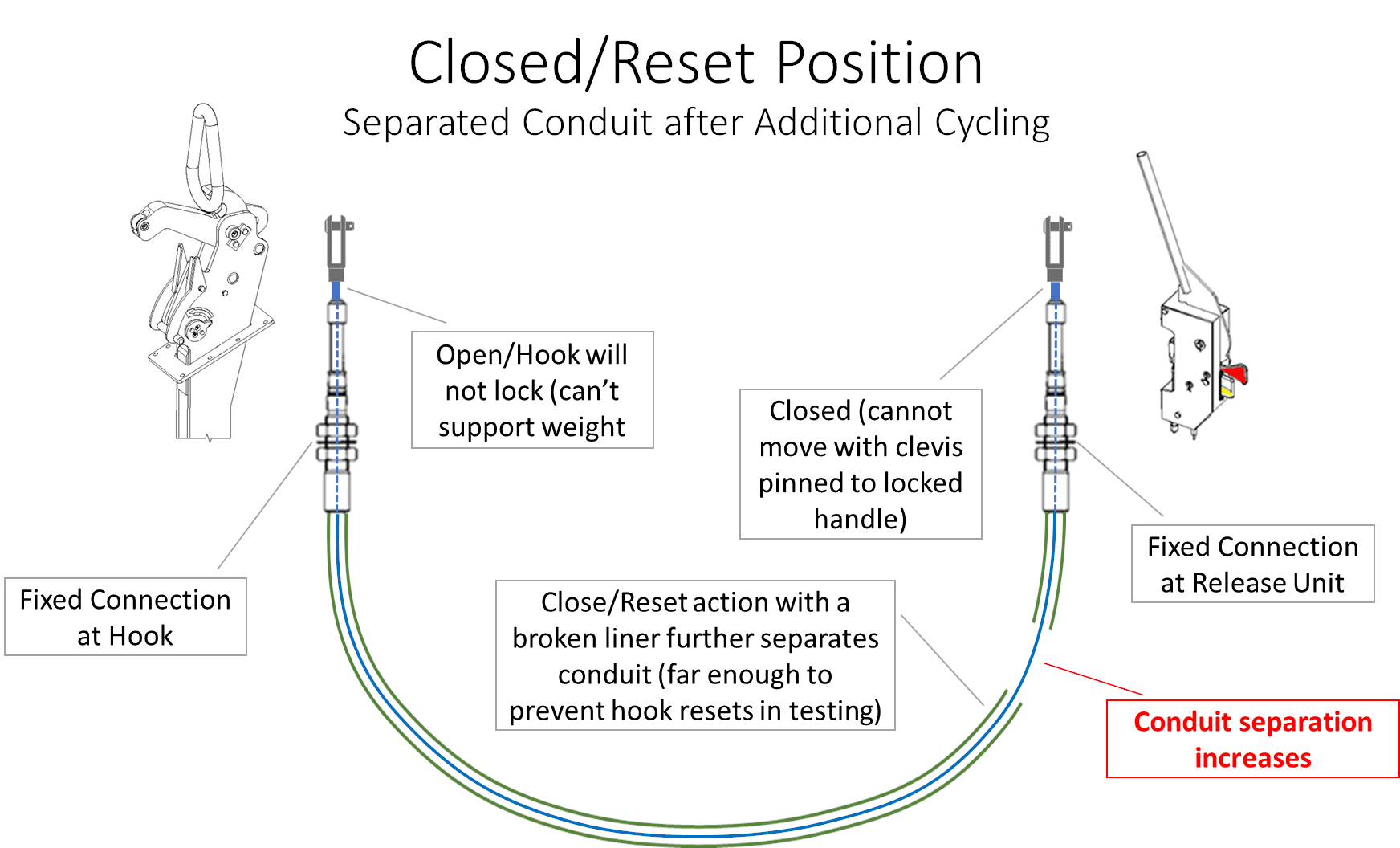 Close/Reset Position with
Close/Reset Position with
separated conduit after additional cycling
Additional cycling (opening and closing) of the release handle during testing showed that the cable conduit would separate before any rotation was transferred to the locking shaft. This condition leaves the hook in an open position that will not support any weight.
USCG Testing of LHR 3.5M2 and Control Cable Failures
The U.S. Coast Guard investigators and members of the OCSNCOE conducted additional testing on January 14, 2020 to determine if theories related to the control cable were plausible and gain additional data. The lifeboat utilized in the tests was the same model and was outfitted with the same release mechanism (hooks and release unit) as the lifeboat that was involved in the casualty. The testing report, listed as Enclosure (2) to the Report of Investigation can be accessed here.
Highlights from the report are listed below. Please see the full report for additional details.
Purpose
The measurements and tests conducted and detailed in this report were developed with the intent to obtain data for the Schat-Harding LHR 3.5M2 release mechanism related to the following:
- The force required to operate the release unit with various loads on the hooks,
- How the operation of the release lever would affect the polyethylene (white) liner of the control cable (e.g. stretch, distortion and/or breakage), and
- How a separated polyethylene liner affects the position of the locking shaft (cam) of the hook with the control cable installed in the same model boat and routed in the same manner as that of AUGER Lifeboat 6 (based on photographic evidence that provides the majority of the cable routing).
Further tests were developed to document what would happen when additional force was applied to the hook with the release system in a compromised state (i.e., locking shaft rotated between the closed and open positions due to a separated polyethylene liner in the control cable).
Report Contents
- Incident & Test Lifeboat Data
- Release Mechanism Components and Operation
- Control Cables
- Cable Routing
- Cable Adjustments
- Cable Components/Construction
- Assumptions
- Force Required to Operate the Release Unit
- Experiment 1 - Control Cable Travel and Hook Locking Shaft Positions
- Experiment 2 - Locking Shaft Movement with Control Cable Damage and Failure
- Experiment 3 - Effects of Additional Forces on the Hook/locking Shaft with a Compromised Control Cable
- Conclusions
Conclusions
The results of these experiments show that damage to the conduit and polyethylene liner can result in failure of the cable. With damage present, a combination of the force required to open the locking shaft and the friction force in the cable itself produces a tensile force in the polyethylene liner that can cause it to fail completely. If the failure occurs while cycling the release lever, it can result in the hook locking shaft stopping between the open and closed positions (“B” and “C” positions, respectively, on Figure 34).
With the locking shaft in a partially-closed position immediately following conduit separation, the hook can still support the weight of the lifeboat and the occupants. Additionally, if the locking shaft is in a position that is relatively close to the open position, but still allows the hooks to be locked, the hooks can support the weight of the boat, though an additional load can cause the locking shaft to rotate and allow the hook to open.
However, it must be emphasized that after the initial liner failure and separation, any further cycling of the system will result in the locking shaft remaining in the fully open position. With a failed liner, the cable conduit freely extends, rendering the system unable to rotate the locking shaft to the closed position. This prevents the hooks from locking, rendering them unable to hold any load (see the observations for Experiment 2, Step 15).
The results of the testing show that a compromised control cable can place the locking shaft in a position that could be forced to open with application of an increased load.
DNV-GL investigation and Forensic Analysis
Shell Offshore Inc. contracted DNV-GL's Pipeline Services Department (i.e., Lab) based in Dublin, OH to assist with the causal investigation into the Auger Lifeboat No. 6 casualty. The Lab performed inspections, testing and analyses of components involved in the incident (subject components), as well as other select components (exemplar components and similar components from other lifeboats on the facility). Laser scanning and 3D modeling, light and scanning electron microscopy and numerous other scientific methods were utilized by the Lab for the investigation. U.S. Coast Guard investigation team members were present for all key stages of testing, both locally and at the Lab's facilities in Dublin. DNV's investigation report, listed as Enclosure (3) to the Report of Investigation can be accessed here.
The contents and conclusions from the report are listed below. Please see the full report for additional details.
Report Table of Contents
- 1.0 BACKGROUND
- 1.1 Lifeboat 6
- 1.2 Summary of the Incident and Recovery Effort
- 1.3 Objective of the Investigation
- 2.0 TECHNICAL APPROACH AND ADDITIONAL BACKGROUND
- 2.1 Field Investigation
- 2.2 Reconstruction and Function Testing
- 2.3 Examination of Key Components
- 2.3.1 Release Unit – Background Information and Examination
- 2.3.2 Hooks –Background Information and Examination
- 2.3.3 Fall Cables and Rings – Background Information and Examination
- 2.3.4 Control Cables – Background Information and Examination
- 2.3.5 Fiberglass Hull and Support Structure – Background Information and Examination
- 3.0 RESULTS
- 3.1 Field Investigation
- 3.1.1 Inspection at Harvey Terminal – July 29 through August 2, 2019
- 3.1.2 Inspection at Harvey Terminal – October 3, 2019
- 3.1.3 Inspection at Harvey Terminal – PSN Visits
- 3.1.4 Auger Lifeboat 6 Davit
- 3.2 Reconstruction
- 3.2.1 Description of Reconstruction Process
- 3.2.2 Function Testing
- 3.2.2.1 Subject Hook, Subject Cable, and Subject Release Unit
- 3.2.2.2 Subject Hook, Exemplar Cable, and Subject Release Unit
- 3.2.2.3 Exemplar Hook, Exemplar Aft Cable, and Subject Release Unit
- 3.3 Examination of Key Components
- 3.3.1 Subject Release Unit
- 3.3.1.1 Visual Inspection
- 3.3.2 Hooks
- 3.3.2.1 Subject Hooks
- 3.3.2.2 Exemplar Hook
- 3.3.3 Fall Cables and Rings
- 3.3.3.1 Visual Examination
- 3.3.3.2 Laser Scanning
- 3.3.4 Cables
- 3.3.4.1 Subject Aft Cable
- 3.3.4.2 Lifeboat 7 & 8 Cables
- 3.3.4.3 Mechanical Testing of Exemplar Cable and Subject Aft Cable
- 3.3.4.4 Load Testing with Exemplar Cable, Exemplar Hook, Exemplar Ring, and Subject Release Unit
- 3.3.5 Fiberglass Hull and Support Structure
- 3.3.5.1 Scanning Electron Microscopy
- 3.3.5.2 Mechanical Testing
- 3.3.5.3 Modeling
- 4.0 FAILURE SCENARIOS
- 4.1 Approach
- 4.2 Failure of Non-Hook System Components
- 4.3 Hook Point Load
- 4.4 Locking Shaft of the Subject Aft Hook Rotated Unintentionally
- 4.4.1 Hook System Components Compromised
- 4.4.2 Control Cable Compromised
- 4.4.2.1 Single Overload Event
- 4.4.2.2 Damage Accumulation
- 5.0 CONCLUSIONS
Conclusions
The results of the investigation indicate that the unintended release of the Subject Aft Hook of Lifeboat 6 was a result of a degraded and compromised aft control cable. The control cable exhibited significant corrosion, full penetration around the circumference, of the structural wire layer allowing for externally applied loads to rotate the locking shaft of the Subject Aft Hook to an open position.
Failure of the Subject Aft Cable is suspected of progressing in the following manner:
(1) mechanical damage to the cover due to contact between the control cable and the helmsman’s console,
(2) water ingress leading to significant corrosion of the wire layer,
(3) voluminous corrosion product resulting in fatigue of the cover layer and the cover opening further, and
(4) buckling and elongation of the liner layer as a repetitive action associated with the functioning of the control cable.
Due to the damage to the Subject Aft Cable, the locking shaft of the Subject Aft Hook was not fully closed (i.e. in a slightly more open position) requiring less rotation to release the hook. The compromised cover and wire layer would have allowed for external loads applied to the control cable to translate onto the inner member of the control cable that is directly linked to the locking shaft, thereby rotating the locking shaft to an open position.
Recommendations from the USCG Report of Investigation (ROI), District Eight Endorsements and Commandant Actions
The following recommendations were made in the ROI and were subject to feedback after release. The review of the recommendations was also presented to the National Offshore Safety Advisory Committee as a task statement on April 26, 2022 (with a 1-year completion period). This investigation was closed as indicated in the Commandant Action Memo, IIA #6762997, dated 02Oct2023, and signed by the Assistant Commandant for Prevention Policy (CG-5P).
The District Commander's endorsement and the Commandant Actions are included at the beginning of the report and address each of the recommendations made by the Investigating Officer in the Report of Investigation. The endorsements and actions are included below in italicized font for ready reference).
Please note that hyperlinks are provided throughout this page to U.S. Coast Guard offices, regulations and documents that are referenced in the recommendations and endorsements to aid in review and/or research.
Safety Recommendations
Safety Recommendation 1: Recommend the Coast Guard Commercial Regulations and Standards Directorate (CG-5PS) develop a working group to look at consolidating lifesaving gear regulations under one subchapter.
District Commander's Endorsement: I partially concur with this recommendation. 46 CFR Subchapter W does not currently apply to OCS facilities, but had it been applicable, the prescriptive lifesaving gear regulations housed therein may have addressed the latent unsafe condition with respect to the degraded control cable before it resulted in this fatal marine casualty. The proposed working group should identify a strategy to update the lifesaving equipment regulations applicable to OCS facilities. Possible options include (1) adding more prescriptive maintenance requirements to 33 CFR Subchapter N, using those in 46 CFR Subchapter I-A and in 46 CFR Subchapter W as a model, or (2) amending 33 CFR Subchapter N to make the requirements of 46 CFR Subchapter I-A and/or 46 CFR Subchapter W applicable to OCS facilities.
Commandant Action: I concur with the intent of this recommendation. The Coast Guard Office of Operating and Environmental Standards (CG-OES) and Office of Design and Engineering Standards (CG-ENG) will establish a working group to consider consolidating lifesaving gear regulations applicable to offshore units; however, I do not concur with the Coast Guard Eighth District’s endorsement to this safety recommendation. While revision to regulations in Title 33 Code of Federal Regulations (CFR) Subchapter N and Title 46 CFR Subchapter W may be warranted, I do not concur with the Eighth District’s suggestion that applying Subchapter W to the Outer Continental Shelf (OCS) would have prevented or mitigated this casualty. While Subchapter W does contain more prescriptive requirements than Subchapter N, they are also outdated.
The International Maritime Organization (IMO) has published new mandatory requirements for maintenance and servicing of lifesaving appliances on vessels subject to Safety of Life at Sea (SOLAS). The U.S. Coast Guard’s implementation of these requirements, which entered into force on January 1, 2020, is contained in Navigation and Vessel Inspection Circular (NVIC) 03-19. At present, the provisions of NVIC 03-19 are not mandatory for vessels not subject to SOLAS, Mobile Offshore Drilling Units (MODU), and offshore facilities. The Coast Guard will consider pursuing mandatory application of these requirements to all Coast Guard approved lifesaving appliances.
Safety Recommendation 2: Recommend the [Lifesaving and Fire Safety Division] CG-ENG-4 review procedures related to release mechanism type approval to ensure all components, to include control cables, are thoroughly addressed in type approval submittals and testing.
District Commander's Endorsement: I concur with this recommendation. This investigation revealed that failure of a control cable could result in the uncontrolled release of a lifeboat. Commandant (CG-ENG- 4) should review 46 CFR 160.133 and associated regulations and procedures, and consider any updates that may be necessary regarding control cables or other components of release mechanisms.
Commandant Action: I concur with this recommendation. The investigation revealed a damaged control cable that was not adequately addressed by the Original Equipment Manufacturer’s (OEM) service provider or the crew. This caused the hook to be in the “almost open” position, followed by an uncontrolled release of the lifeboat. While this failure was the result of inadequate maintenance and inspection, which if done properly should have identified the damaged cable, it is concerning that damage to this single component resulted in catastrophic failure of the mechanism itself. The Coast Guard will update internal procedures to highlight review of the control cables and other critical components, to ensure that they are compliant with existing requirements, and would not result in a fail-unsafe condition. Additionally, the Coast Guard will undertake a comprehensive review of the International Life-Saving Appliance (LSA) Code (incorporated by reference in 46 CFR 160.133) to determine if updates to the testing and approval requirements are needed to prevent cable degradation from leading to uncontrolled hook release.
As stated above, the IMO has published new mandatory requirements for maintenance and servicing of lifesaving appliances on vessels subject to SOLAS. To address concerns related to maintenance of in-service equipment, the U.S. Coast Guard will consider mandatory application of these requirements for those vessels not covered by the new requirements.
Safety Recommendation 3: Recommend that the Office of Commercial Vessel Compliance (CG-CVC) develop regulations requiring thorough annual inspections (including inspection of entire length of cable) and time-based and/or condition-based replacement. Most appropriately, these regulations would apply to all lifeboats. In the absence of rulemaking, the CG-CVC should issue strong recommendations to OEMs and operators that they voluntarily apply the same.
District Commander's Endorsement: I concur with the intent of this recommendation. I recommend that Commandant [Office of Operating and Environmental Standards] (CG-OES) develop standards, applicable to all U.S. vessels and OCS facilities, requiring the annual inspection of the control cables and time-based and/or condition-based replacement. I note that Commandant (CG-INV) issued Safety Alert 03-20 on February 5, 2020, which strongly recommends that lifeboat owners, manufacturers, operators, and service providers implement an inspection regime that allows for cable damage to be identified, and, as necessary, for cables to be replaced in a timely manner.
Commandant Action: I concur with the intent of this recommendation. Currently, NVIC 03-19 titled “Maintenance, Thorough Examination, Operational Testing, Overhaul and Repair of Lifeboats and Rescue Boats, Launching Appliances and Release Gear” provides guidance
for annual lifeboat inspection and replacement criteria. The Coast Guard’s Outer Continental Shelf National Center of Expertise (NCOE) and the Eighth District’s Officers in Charge, Marine Inspection (OCMIs) are consulting to update the aforementioned guidance and research any revisions to current regulations. The Coast Guard has also published Safety Alert 03-20, titled “Check Your Lifeboat Cables: Damaged Control Cables Can Contribute to the Unintended Opening of a Hook,” which addresses the importance of checking for and replacing damaged control cables that operate between the release handle and hook in a lifeboat hook release system.
Safety Recommendation 4: Recommend [that the Lifesaving and Fire Safety Division] CG-ENG-4 develop regulations that require that all approved components are approved as a system or are designed to work together (e.g. specific winches allowed to be used with a particular davit, release mechanisms allowed to be used in a specific boat, etc.).
District Commander's Endorsement: I concur with this recommendation. All approvals should ensure that release mechanisms approved under 46 CFR 160.133 properly interface with the launching appliances approved under 46 CFR 160.115 and 160.132. The replacement of any component should require notification and further review of the system by the OCMI and/or Commandant [Office of Design and Engineering Standards] (CG-ENG).
Commandant Action: I concur with the intent of this recommendation. A full complement of primary lifesaving appliances typically consists of a craft, a release mechanism, a davit, and a winch. While these four components are sometimes produced by the same manufacturer, this is not always the case and there is no requirement to do so. Imposing such a requirement would create undue burden on the equipment manufacturers and make U.S. Coast Guard approved lifesaving appliances more expensive and difficult to source. CG-ENG currently approves the individual lifesaving appliances but is not routinely involved in the plan review of lifesaving arrangements and installation of those arrangements on U.S. vessels or OCS units. This review is done by the Marine Safety Center (MSC), the cognizant OCMI, and/or the relevant classification society. Final approval of lifesaving plans is the responsibility of the cognizant OCMI. There is a gap in the requirements as to when this review of arrangements occurs, and no clear requirement is in place to evaluate the compatibility of the components in the system. The Coast Guard will address this gap by clarifying guidance for plan review and inspection of lifesaving appliances.
Safety Recommendation 5: Recommend the [Coast Guard Commercial Regulations and Standards Directorate] CG-5PS develop regulations that require the maintenance requirements in 46 C.F.R. § 109 (or similarly structured requirements) to be applicable to FOFs. NOSAC’s report, due September 9, 2020, can help inform this process.
District Commander's Endorsement: I concur with the intent of this recommendation. 46 CFR Part 109 is not applicable to OCS facilities but the more prescriptive maintenance requirements therein may have addressed the latent unsafe condition with respect to the degraded control cable. As discussed above under Recommendation 1, a working group should identify a strategy to update lifesaving gear regulations applicable to OCS facilities.
Commandant Action: I concur with the intent of this recommendation. The IMO has published new mandatory requirements for maintenance and servicing of lifesaving appliances on vessels subject to SOLAS. These new requirements entered into force on January 1, 2020. Coast Guard guidance on the implementation of these requirements is contained NVIC 03-19 titled, “Maintenance, Thorough Examination, Operational Testing, Overhaul and Repair of Lifeboats and Rescue Boats, Launching Appliances and Release Gear.” At present, the provisions of NVIC 03-19 are not mandatory for vessels not subject to SOLAS, MODUs, and offshore facilities. The Coast Guard will consider mandatory application of these requirements.
Safety Recommendation 6: Recommend [the Coast Guard Commercial Regulations and Standards Directorate] CG-5PS reevaluate the use of lifeboats as rescue boats. During witness testimony it was noted the freeboard was too high to lift an unconscious person into the boat and the doors were not wide enough to allow two persons to lift an unconscious person through.
District Commander's Endorsement: I concur with the intent of this recommendation. In accordance with 46 CFR 108.510(b), OCS facilities constructed before October 1, 1996, such as AUGER, are not currently required to have rescue boats. The working group discussed in Recommendation 1 and 5 should determine if all FOFs, regardless of build date, should be equipped with an approved rescue boat.
Commandant Action: I concur with the intent of this recommendation. On November 13, 2012, the Coast Guard published recommended interim guidance for Lifesaving and Fire-Fighting Equipment, Training and Drills Onboard Offshore Facilities and MODUs operating on the OCS (77 FR 70172), in the aftermath of the explosion, fire, and sinking of DEEPWATER HORIZON. This guidance encourages, among other safety improvements, the use of a dedicated rescue boat on MODUs and manned offshore facilities. Additionally, the IMO MODU Code has been updated to include this provision. The Coast Guard will pursue options to propose mandatory application of this provision.
Safety Recommendation 7: Recommend the [Coast Guard Commercial Regulations and Standards Directorate] CG-5PS develop regulations ensuring oversight of lifeboat, winch and davit repairs and modifications all vessels and facilities not subject to 46 C.F.R. Subchapter W, Lifesaving Appliances and Arrangements.
District Commander's Endorsement: I concur with the intent of this recommendation. I recommend that Commandant (CG-5PS) consider the development of regulations requiring notification to the cognizant OCMI when an operator intends to conduct repairs or modifications to primary lifesaving equipment on an OCS Facility.
Commandant Action: I concur with the intent of this recommendation. CG-OES is in consultation with the Outer Continental Shelf NCOE and the Eighth District OCMI to consider development of regulations requiring notification to the cognizant OCMI when an operator intends to conduct repairs or modifications to primary lifesaving equipment on an OCS Facility.
Safety Recommendation 8: Recommend [the Coast Guard Commercial Regulations and Standards Directorate] CG-5PS develop policy that ensures OCMIs and their representatives properly evaluate type approved equipment in regards to repairs and modifications (especially as they relate to serviceability and maintaining equipment in an as-approved condition), and that CG-ENG-4 remains engaged appropriately in these activities as necessary after initial approval.
District Commander's Endorsement: I concur with the intent of this recommendation. I recommend that Coast Guard Force Readiness Command (FORCECOM) also evaluate Marine Inspector training on this topic, taking into account the information in this report, and if necessary develop training to ensure USCG Marine Inspectors are properly equipped to complete oversight activities.
Commandant Action: I concur with the intent of this recommendation. CG-CVC will review existing guidance and/or training to identify knowledge or process gaps. The Coast Guard will update or develop guidance to assist OCMIs in evaluating Coast Guard type-approved equipment.
Safety Recommendation 9: Recommend the D8 OCMI (ocs) update current policy on drill and maintenance requirements for regulated facilities operating on the OCS to best reflect current regulatory requirements.
District Commander's Endorsement: I concur with the intent of this recommendation. The D8 OCS OCMI published Policy Letter 01-2020, which clarified emergency evacuation drill requirements but did not address the maintenance requirements in 33 CFR 146.15. As noted in my endorsement of Safety Recommendations 1 and 5, I recommend that Commandant (CG-5PS) consider potential updates to lifesaving gear regulations applicable to OCS facilities, particularly with regard to more prescriptive maintenance requirements. In the meantime, I have directed the D8 OCS OCMI to review current guidance and consider the most appropriate means to ensure compliance with the intent of current regulations.
Commandant Action: I concur with the intent of this recommendation. On May 19, 2020, the Eighth Coast Guard District published Policy Letter 01-2020 titled “Emergency Evacuation Drills on Manned Facilities with Lifeboats.” As mentioned in the responses to Recommendations 1, 2, and 5, the IMO has published new mandatory requirements for maintenance and servicing of lifesaving appliances on vessels subject to SOLAS. These new requirements were entered into force on January 1, 2020. Coast Guard guidance on the implementation of these requirements is contained in NVIC 03-19 titled “Maintenance, Thorough Examination, Operational Testing, Overhaul and Repair of Lifeboats and Rescue Boats, Launching Appliances and Release Gear.” At present, the provisions of NVIC 03-19 are not mandatory for vessels not subject to SOLAS, MODUs, and offshore facilities. The Coast Guard will consider mandatory application of these requirements.
Safety Recommendation 10: Recommend the [Coast Guard Commercial Regulations and Standards Directorate] CG-5PS, with input and involvement by the OCS NCOE, develop a workgroup to research/revise regulations and policies and engage with other administrations for input into their management of the following for the offshore oil & gas operations:
- Lifeboat launching;
- Drills and competence; and
- Maintenance.
District Commander's Endorsement: I concur with this recommendation. The group should include the D8 OCS OCMI. In addition, I recommend this work group reach out to the Bureau of Safety and Environmental Enforcement (BSEE) to evaluate if the above activities should also be incorporated in the Safety and Environmental Management System under 30 CFR 250.1915 and 250.1916.
Commandant Action: I concur with this recommendation. CG-OES in consultation with the OSC NCOE and the Eighth Coast Guard District OCMI will develop working groups to research and make any necessary revision to regulations and policies. The Coast Guard will also engage with other foreign Flag administrations for input into their management of the following for the offshore oil & gas operations:
- Lifeboat launching;
- Drills and competence; and
- Maintenance.
Administrative Recommendations:
Administrative Recommendation 1: Recommend the D8 OCMI (ocs), after being routed and reviewed by [the Office of Investigations & Casualty Analysis] CG-INV, communicate Findings of Concern to the OEM, recommending:
- The OEM update work instructions to automatically replace control cables five years from the date the cables were installed.
- The OEM update all work instructions to better communicate the nature of repair or replacement recommendations, the risk posed by the deficiency, and a recommended timeline for repair or replacement.
- The OEM review and revise their procedures for release mechanism control cable installations and inspections and provide training on the same to their technicians.
- The OEM conduct a review of its hook indicator color coding system to determine whether the current system (red means open; green means closed) is confusing for operators.
District Commander's Endorsement: I concur with the intent of this recommendation. The investigation revealed the critical importance of the release cable and the necessity to improve the level of oversight and associated training by OEMs. Additionally, this investigation discovered that lifeboat crew members may be confused by the color scheme utilized to demonstrate with "open/closed" on lifeboat hooks, and that this confusion could lead to additional marine casualties. I recommend that Commandant (CG-ENG) notify OEMs of these Findings of Concern and associated recommendations.
Commandant Action: I concur with this recommendation. The Coast Guard will forward this investigation report, the Findings of Concern, and associated recommendations to the OEMs for their consideration.
Administrative Recommendation 2: Recommend the D8 OCMI (ocs), after being routed and reviewed by [the Office of Investigations & Casualty Analysis] CG-INV, communicate Findings of Concern to the Operator, recommending:
- The Operator incorporate all OEM recommended maintenance into their maintenance system as mandatory.
District Commander's Endorsement: I concur with this recommendation. This investigation revealed that it is paramount that emergency gear be kept in good condition at all times, which may have been achieved by promptly acting upon all OEM recommendations. This investigation concluded that the OEM had made a recommendation to the Operator that the control cable in Lifeboat NO.6 be replaced, and that such replacement was not accomplished.
District Action: The D8 OCS OCMI will draft an appropriate Finding of Concern to communicate recommendations to the Operator, including incorporation of OEM recommendations into their maintenance system, as well as clarification of roles and expectations between the OEM and the Operator.
Commandant Action: I concur with this recommendation. In addition to the approved OEM manual, there are repair orders generated during periodic servicing. These should also be considered mandatory. These Findings of Concern will be passed to the Operator of the Shell AUGER and will also be taken into account in clarifying regulatory or policy guidance on servicing of Life Saving Appliances.
Administrative Recommendation 3: Recommend [the Office of Investigations & Casualty Analysis] CG-INV issue a finding of concern recommending that operators ensure that persons planning, conducting and overseeing routine lifeboat maintenance have read and are familiar with the applicable lifeboat operations and maintenance manual.
District Commander's Endorsement: I concur with this recommendation. This investigation highlighted the importance that those crew members charged with regular maintenance and inspection duties be thoroughly familiar with the components of lifeboats with which they interact. With the assistance of the D8 OCS OCMI and the OCS NCOE, CG-INV should communicate this importance to vessel and OCS facility operators via a Finding of Concern.
Commandant Action: I concur with this recommendation. CG-INV published Finding of Concern 17-23 to address the recommended issues.
Administrative Recommendation 4: Recommend [the Office of Investigations & Casualty Analysis] CG-INV issue a finding of concern recommending operators, with the assistance of the OEM, train crews to ensure they understand how the hook indicators, when installed, function and convey information regarding the condition of the hook. Operators and OEMs should also communicate to crews the need to verify the status of the hook indicator at least two times during the retrieval process: at the water after the falls are connected and immediately after the lifeboat clears the water.
District Commander's Endorsement: I concur with this recommendation. Commandant (CG-INV) should communicate the importance of ensuring those associated with lifeboat duties on vessels and OCS facilities understand the functions of the lifeboat hook and color position indicators.
Commandant Action: I concur with this recommendation. CG-INV published Finding of Concern 17-23 to address the recommended issues.
Administrative Recommendation 5: [The Office of Investigations & Casualty Analysis] CG-INV and [the Office of Commercial Vessel Compliance] CG-CVC should widely publicize this investigation’s findings related to the hazards posed by compromised control cables to all marine sectors maintaining and operating lifeboats, to include Coast Guard inspectors.
District Commander's Endorsement: I concur with this recommendation and note that some of the findings have already been disseminated via Safety Alert 03-20. Additionally, the information in this Report of Investigation should be utilized when training CG Marine Inspectors.
Commandant Action: I concur with this recommendation. CG-INV and CG-CVC collaboratively drafted and published Safety Alert 03-20 to strongly encourage owners and operators to ensure lifeboat cables are periodically inspected for damage and replaced as necessary. In February 2020, CG-CVC notified Chiefs of Inspection of the Safety Alert. The Report of Investigation was released to the public ahead of this Final Action Memorandum via a Coast Guard Maritime Commons Blog on December 17, 2021.
Administrative Recommendation 6: [The Office of Commercial Vessel Compliance] CG-CVC and [the Lifesaving and Fire Safety Division] CG-ENG-4 should provide additional guidance to inspectors and the regulated community regarding certificates of approval regulated under 46 CFR 2.75-5. This guidance should include clarity on who they are issued to, how they relate to the sale and production of equipment, the significance of their validity period, and what constitutes replacement in kind of equipment no longer holding a valid approval certificate.
District Commander's Endorsement: I concur with this recommendation. In the course of this investigation it was discovered that Lifeboat NO.6 had been sold multiple times. As indicated in this Report of Investigation, especially sections 4.3.4.2.1 and 5.10, there is lack of clarity regarding how to correctly apply certain provisions of 46 CFR 2.75 and 46 CFR 160.135-23. Additional guidance for Marine Inspectors would be useful.
Referenced ROI sections (for ready reference):
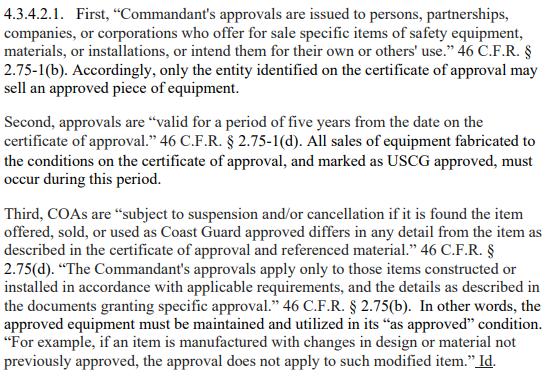
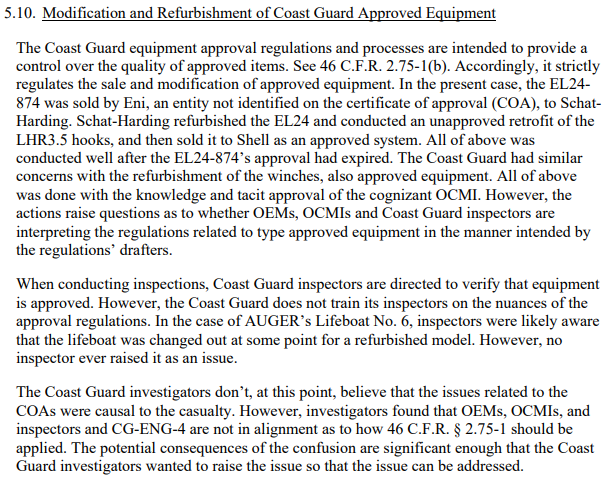
Commandant Action: I concur with this recommendation. The Coast Guard will provide further guidance to inspectors and the regulated community regarding Certificates of Approval (COAs) [see "Facts about COAs" in the CG-ENG-4 General FAQs] required under 46 CFR 2.75-5.
Administrative Recommendation 7: Recommend the [Office of Investigations & Casualty Analysis] CG-INV issue a finding of concern that highlights the benefits of using FPDs during lifeboat launches and retrieval drills.
District Commander's Endorsement: I concur with this recommendation. Commandant (CG-CVC) and CG-ENG-4) should review the efficacy of utilizing Fall Protection Devices for training and maintenance evolutions.
Commandant Action: I do not concur with this recommendation. The Coast Guard has significant concerns regarding the use of fall prevention devices (FPDs) and encouraging their widespread use could lead to negative unintended consequences. IMO MSC.1/Circ.1327 clearly states that FPDs are intended to be used only as an interim risk mitigation measure for existing on-load release hooks until such time that improved design and performance criteria are implemented. The use of FPDs introduces operational risks and should not be a replacement for proper maintenance and inspection of lifeboat systems. This policy is confirmed in ENG Policy Letter 01-14.
While FPDs can be beneficial during training, they will prevent deployment during an emergency if they are accidentally left on the lifeboat after the training. Any crew and/or OEMs who use FPDs during training should acknowledge and mitigate the risks of usage.
Administrative Recommendation 8: Recommend that this investigation be closed.
District Commander's Endorsement: I concur with this recommendation.
Commandant Action: This investigation was closed as indicated in the Commandant Action Memo, IIA #6762997, dated 02Oct2023, and signed by the Assistant Commandant for Prevention Policy (CG-5P).
Findings of Concern
Findings of Concern 17-23 (Correction 1) was published on October 13, 2023 upon Commandant Actions and closing of the investigation. This document summarizes the incident, the contributing factors and the analysis.
USCG Findings of Concern
1) Coast Guard investigators have identified the following recommended actions for an owner or operator of OCS facilities or vessels with lifeboats that conduct similar operations to consider. These recommendations may reduce the likelihood of reoccurrence:
- Owners and operators of lifeboats are recommended to thoroughly review and incorporate all OEM recommended maintenance into their existing and future maintenance systems. Roles and expectations between the OEM or authorized service provider and the owner/operator should also be clarified as part of the owner/operator’s maintenance system (if applicable) and before every servicing of lifesaving appliances.
- Owners and operators are recommended to ensure all persons planning, conducting, and overseeing lifeboat maintenance and inspection duties have read and are thoroughly familiar with the operations and maintenance manual that is specific to the lifeboat(s) being serviced.
- Owners and operators are recommended to conduct training with OEMs and lifeboat crews to ensure a thorough understanding of how installed hook indicator’s function and convey information regarding the status of the hook. The training should include teaching crews to verify the status of the hook indicator at least twice throughout the retrieval process; once at the water after the falls are connected and immediately after the lifeboat clears the water and prior to hoisting to stowage height.
2) Coast Guard investigators have identified the following recommended actions for OEMs of lifeboats that may reduce the likelihood of reoccurrence:
- OEMs evaluate all work instructions to determine if items that are "recommended for replacement" should be changed to "required for replacement".
- OEMs ensure technicians are trained to communicate the urgency of the deficiency, risk associated with use prior to repair and, if needed, a timeline for repair.
- OEMs review and revise their procedures for release mechanism control cable installations and inspections and provide training on the same to their technicians to ensure that control cable condition is fully evaluated during routine servicing.
- OEMs conduct training with crews to ensure familiarity with hook and control markings and their meanings.